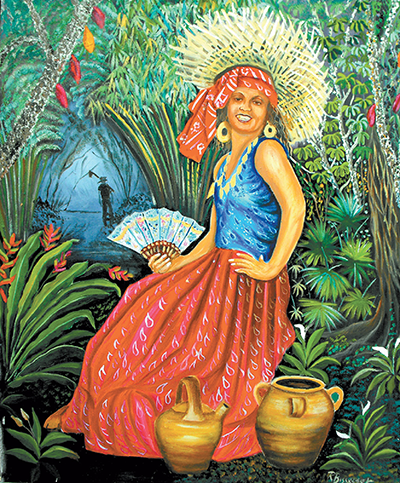 The tale of the La Diablesse originated on the island of Martinique more than three hundred years ago. One has to understand the demonising of the personalities even then and how women were viewed in the Caribbean landscape then and now. Women were viewed as slaves and servants, objects of abuse and the murder of women and instances of severe mutilation were often overlooked by the authorities, especially women of coloured descent. La Diablesse is symbolic of a woman taking a stance against the atrocities of the time. While she was accused of several murders, she stands today in my painting and the writings of my son Angelo Bissessarsingh as being absolved by history and exonerated of her crimes. Her mutilated body is now depicted in disguise and what comes to us is a beautiful smiling coloured woman, not the horrible demon with vampire teeth and fiery eyes. Her image in the Caribbean landscape as a champion of woman’s rights to life and happiness rings through time in Angelo’s writing. —Rudolph Bissessarsingh In the rich pantheon of local folkore, it is the fusion of French and West-African identities which gave us the colourful characters which have danced in the stories of our forefathers, handed down like cherished heirlooms from generation to generation. Earlier this year, I wrote about how the African griot, or storyteller, found new material here in the sugar plantations of the Caribbean where he and his fellows were brutally enslaved. Trinidad was to receive an infusion of French culture from 1783 when Roume de St Laurent (with the support of the Spanish crown) promulgated the Cedula de Poblacion which offered a land grant to Roman Catholic immigrants and their slaves. Hundreds of French planters fleeing the seeds of revolution and their chattels came to the island and created a French colony with Spanish rule, which was later to be replaced by British dominion in 1797. The La Diablesse looms tall in the annals of our mythology. She is the devil woman, the temptress and seductress whose wiles would entrap any man whose ill luck led him into her path. She is both the paragon of womanly beauty and the image of demonic lust. La Diablesse is well known to all who cherish the stories of yesteryear. Almost every village in Trinidad (particularly in the hamlets of the Northern Range) has a yarn to weave about the beautiful woman in the Martiniquan dress—voluminous skirts, head-tie, hat perched jauntily on her head—who waits along the lonely paths for heedless menfolk who would digress from their courses to accommodate a pretty face. Those skirts veil, however, the sinister feature for which La Diablesse is infamous, namely the cloven hoof; the cow-foot which distinguishes her from mortal women. It is largely possible that Martinique was the place of origin of the La Diablesse, since many French settlers came from this island, and the devil woman herself almost always makes an appearance clothed in the style which has become synonymous with the French Antilles. She appears on the nights when the full moon is the only light that pierces the darkness and she waits on those removed byways where a man is likely to pass. The eminent 19th-century traveller and writer Lafcadio Hearn spent two years in the West Indies in the 1880s and though he visited Trinidad, the majority of his stay was in Martinique where he documented several aspects of the French Creole culture. It was Hearn’s memoirs of his West Indian sojourn that introduced La Diablesse to the wider world. In a quarter of the city of St Pierre (which was destroyed with massive loss of life by a volcanic eruption in 1902) he wrote: “Mostly she haunts the mountain roads, winding from plantation to plantation, from hamlet to hamlet. But close to the great towns she sometimes walks: she has been seen at mid-day upon the highway which overlooks the Cemetery of the Anchorage, behind the cathedral of St Pierre.” In Mr Hearn’s narration, La Diablesse is a tall woman of Afro extraction, simply but elegantly clad and all the men know and fear her. One of the more foolhardy, Fafa, sees her as she passes through his street and falls under her charming spell as she croons a bewitching patois rhythm and takes to a precipitous road leading to the heights above St Pierre. Fafa’s compere Gaboux follows at a distance but after a while turns in horror and flees since he has seen her most terrible trait—the cloven hoof that hides beneath the sweeping hem of her madras skirts. Onward and upward Fafa follows the temptress as the craggy roadway arches away from the last signs of humanity towards the gloom of the forest where the dread fer-de-lance makes his lair. He is now beginning to feel fear but his infatuation supersedes this warning. Now they are on the summit of a mountain and she reaches for his hand. Hers is as cold as ice as she speaks loving words to the spellbound Fafa. The account written by Mr Hearn terminates thus: “And she, suddenly—turning at once to him and to the last red light, the goblin horror of her face transformed, shrieks with a burst of hideous laughter: “KISS ME NOW.” For the fraction of a moment he knows her name: then, smitten to the brain with the sight of her, reels, recoils, and, backward falling, crashes 2,000 feet down to his death upon the rocks of a mountain torrent.” here to edit. Source: Trinidad Guardian, written by the late Angelo Bissessarsingh The Virtual Museum of Trinidad & Tobago
0 Comments
Leave a Reply. |
T&T news blogThe intent of this blog is to bring some news from home and other fun items. If you enjoy what you read, please leave us a comment.. Archives
May 2025
Categories
All
|

 RSS Feed
RSS Feed